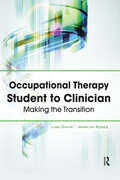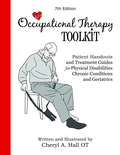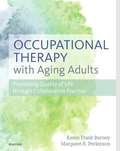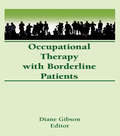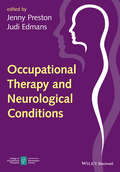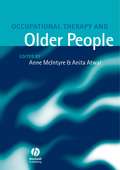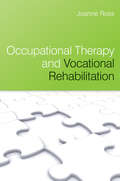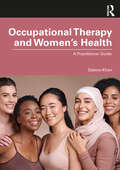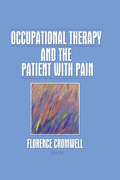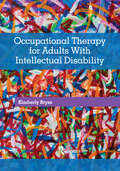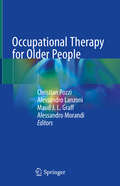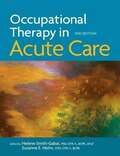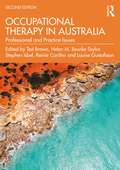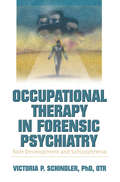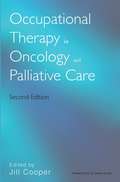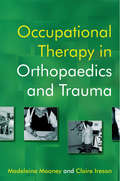- Table View
- List View
Occupational Therapy Student to Clinician: Making the Transition
by Lisa Davis Marilyn RoseeIt is surprising that there is no “go-to” resource for the occupational therapy or occupational therapy assistant student to have when they embark on their professional journey. With this in mind, Lisa Davis and Marilyn Rosee have written Occupational Therapy Student to Clinician: Making the Transitionto help students hone the skills employers look for in new hires. While many academic programs cover career-oriented topics, this is the first specific text to pull the pieces together with the purpose of showing readers how to become successful job candidates and employees. Perfect for the student preparing for an occupational therapy career, Occupational Therapy Student to Clinician covers all pragmatic issues that students face while securing their first job. This text outlines a variety of topics including résumé writing, interview skills, negotiating a salary, working within a team, developing professional competencies, and understanding the culture of an organization. Each chapter includes learning objectives and lists of practice activities that students can use to reinforce their skills.Occupational Therapy Student to Clinician: Making the Transition will benefit occupational therapy and occupational therapy assistant students preparing to graduate, as well as employed clinicians dealing with specific employment-related issues. This text will also guide the employee who wants to move to the next job and reacquaint themselves with the job-seeking process. This comprehensive resource provides strategies and solutions for many employment challenges and will be an asset in any professional development curriculum.
Occupational Therapy Toolkit: Treatment Guides And Patient Education Handouts
by Cheryl A. HallFully revised and expanded in 2018. The Occupational Therapy Toolkit 7th edition is a collection of 354 full-page illustrated patient handouts. The handouts are organized by 97 treatment guides and are based on current research and best practice. This 787 page practical resource is the BEST resource for every therapist working with physical disabilities, chronic conditions or geriatrics.
Occupational Therapy With Aging Adults: Promoting Quality Of Life Through Collaborative Practice
by Karen Barney Margaret PerkinsonLook no further for the book that provides the information essential for successful practice in the rapidly growing field of gerontological occupational therapy! Occupational Therapy with Aging Adults is a new, comprehensive text edited by OT and gerontological experts Karen Frank Barney and Margaret Perkinson that takes a unique interdisciplinary and collaborative approach in covering every major aspects of geriatric gerontological occupational therapy practice. With 30 chapters written by 70 eminent leaders in gerontology and OT, this book covers the entire continuum of care for the aging population along with special considerations for this rapidly growing demographic. This innovative text also covers topical issues spanning the areas of ethical approaches to treatment; nutrition and oral health concerns; pharmacological issues; low vision interventions; assistive technology supports; and more to ensure readers are well versed in every aspect of this key practice area.
Occupational Therapy With Borderline Patients
by Diane GibsonThis volume discusses and reviews the current knowledge in the concept and management of activity groups designed for borderline patients, who are defines as those with “self-destructive and maladaptive interpersonal relations.”
Occupational Therapy and Neurological Conditions
by Judi Edmans Jenny PrestonAn introductory, comprehensive textbook covering all aspects of the occupational needs of clients with neurological conditions. Written from an occupational perspective and for the needs of occupational therapists and their clients Ideal for students and newly qualified practitioners to provide them with an overview of this key area of practice Includes case studies to place material within the context of practice Officially endorsed by the College of Occupational Therapists
Occupational Therapy and Older People
by Anita Atwal Anne McintyreThis book locates older people as major clients of occupational therapy services. It provides a comprehensive resource for students and a basic working reference for clinicians. The book encompasses current theories, debates and challenges which occupational therapists need to engage in if they are to provide pro-active and promotional approaches to ageing. Detailed coverage of bodily structures, functions and pathologies leads onto chapters dedicated to activity, occupation and participation. The ethos of the book is to inspire innovation in the practice of occupational therapy with older people, promoting successful ageing that entails control and empowerment. This new edition has been fully revised and updated. In addition brand new material has been included on occupational transitions (retirement, frailty and end of life); user perspectives; public health including advocacy, enablement and empowerment; people entering old age with disability and mental health conditions; visual impairment; assistive technology driving and ageism.
Occupational Therapy and Older People (Coursesmart Ser.)
by Anita Atwal Anne McIntyreThis timely book locates older people as major clients of occupational therapy services. It provides a comprehensive resource for students and a basic working reference for clinicians. The book encompasses current theories, debates and challenges which occupational therapists need to engage in if they are to provide pro-active and promotional approaches to ageing. Detailed coverage of bodily structures, functions and pathologies leads onto chapters dedicated to activity, occupation and participation. The ethos of the book is to inspire innovation in the practice of occupational therapy with older people, promoting successful ageing that entails control and empowerment. Features: Contains many practical elements, including case studies, and narratives from practice. Promotes active ageing. Adopts the framework of the World Health Organisation’s International Classification of Functioning, Disability and Health (2001) Specialist contributions reveal the diversity of occupational performance considerations in older age.
Occupational Therapy and Spirituality (Routledge Advances in Occupational Science and Occupational Therapy)
by Barbara HemphillSpirituality is an important aspect of occupational therapy theory and practice, yet it remains little understood. This timely book adds to the current debate by exploring the meaning of spirituality within occupational therapy and by outlining evidence which supports this area of practice. Beginning with the three stances surrounding spirituality for the common good and the theology of occupation, throughout its 10 chapters the book goes on to cover topics such as: Spirituality of caring; Theories of spiritual development; Definition of spirituality from occupational therapy literature; Differences between assessing spirituality and religion; Spirituality and ethics; Spiritual and cultural diversity in the occupational therapy clinic; Therapeutic self. By the end of the volume the reader will have the toolset required to consider spiritual concepts and their application to health principles. Occupational Therapy and Spirituality is written in an accessible format and is designed for occupational therapy and occupational science academics, researchers, and graduate students.
Occupational Therapy and Stroke
by Judi EdmansOccupational Therapy and Stroke guides newly qualified occupational therapists (and those new to the field of stroke management) through the complexities of treating people following stroke. It encourages and assists therapists to use their skills in problem solving, building on techniques taught and observed as an undergraduate.Written and edited by practising occupational therapists, the book acknowledges the variety of techniques that may be used in stroke management and the scope of the occupational therapist's role. Chapters span such key topics as early intervention and the theoretical underpinnings of stroke care, as well as the management of motor, sensory, cognitive and perceptual deficits. They are written in a user-friendly style and presented in a form that enables the therapist to review the subject prior to assessment and treatment planning. Complex problems are grouped together for greater clarity.This second edition has been fully revised and updated in line with the WHO ICF model, National Clinical Guidelines and Occupational Therapy standards. It is produced on behalf of the College of Occupational Therapists Specialist Section - Neurological Practice.
Occupational Therapy and Vocational Rehabilitation
by Joanne RossThis book introduces the occupational therapist to the practice of vocational rehabilitation. As rehabilitation specialists, Occupational Therapists work in a range of diverse settings with clients who have a variety of physical, emotional and psychological conditions. Research has proven that there are many positive benefits from working to health and well-being. This book highlights the contribution, which can be made by occupational therapists in assisting disabled, ill or injured workers to access, remain in and return to work.
Occupational Therapy and Women’s Health: A Practitioner Guide
by Sabina KhanThis innovative and comprehensive textbook provides a detailed exploration of the role of occupational therapy in addressing the unique needs of women across the lifespan.Structured into 14 parts, the book begins with the foundations of women’s health, delving into its historical evolution, the significance of gender equality in medical research, the implications of employment on women's well-being, intricate sociocultural influences, and the intersection of women and occupation from an occupational therapy perspective. Following this foundational context, the book journeys through diverse areas such as gynecological and obstetric health management, endocrine health, autoimmune conditions, non-cisgender health in the context of women’s health, mental health and biopsychosocial aspects, cardiovascular health, sleep, weight, and lifestyle factors, oncology, neurological health, women's health across the lifespan, inter-partner violence and trauma-informed care, and special topics in women's health.Women’s health is a universal concern that transcends geographical boundaries, cultural differences, and socioeconomic disparities, and this important book will be key reading for both students and practitioners of occupational therapy.
Occupational Therapy and the Patient With Pain
by Florence S CromwellThis volume speaks to the issue of occupational therapy practice with the patient in pain. The hows and whys of treatment are explored in a broad range of chapters written by and for professionals in the field of occupational therapy.
Occupational Therapy for Adults With Intellectual Disability
by Kimberly BryzeOccupational Therapy for Adults With Intellectual Disability provides occupational therapy practitioners and students with occupation-based solutions to serve and empower individuals with intellectual disabilities, as well as their families and caregivers, towards more self-determined, authentic lives.There are few texts that exist within occupational therapy that support this population. Dr. Kimberly Bryze and the contributing authors are all occupational therapists who have or currently provide occupational therapy services to adults with intellectual disability in various settings. They bring their expertise in scholarship and offer thoughtful, evidence-based approaches for practitioners to create change for individuals, communities, organizations, and society.This text presents an occupational perspective of individuals with intellectual disability given its focus on the following: quality of living social well-being role competence occupational identity self-advocacy occupational justice Occupational Therapy for Adults with Intellectual Disability is ideal for occupational therapy educators who teach content related to adults with intellectual and developmental disabilities, occupational therapy practitioners who provide services to adults with intellectual disability in various clinical, community, and residential settings, and occupational therapy students. Included with the text are online supplemental materials for faculty use in the classroom.The intentional, occupational focus ensures that the content is consistent with recommended practice in current occupational therapy. Occupational therapy practitioners will look to this text to provide evidence-based interventions and when developing consultative programs for persons with intellectual disability across many different settings.
Occupational Therapy for Children - Elsevier on VitalSource
by Jane Clifford O'Brien Jane Case-SmithUnique Evolve Resources website reinforces textbook content with video clips and learning activities for more comprehensive learning. Case studies help you apply concepts to actual situations you may encounter in practice. Evidence-based practice focus reflects the most recent trends and practices in occupational therapy. Unique! Chapter on working with adolescents helps you manage the special needs of this important age group. Unique! Research Notes boxes help you interpret evidence and strengthen your clinical decision-making skills. Video clips on a companion Evolve Resources website reinforce important concepts and rehabilitation techniques.
Occupational Therapy for Older People
by Christian Pozzi Alessandro Lanzoni Maud J. L. Graff Alessandro MorandiThis book focuses on evidence-based occupational therapy in the care of older adults in different clinical settings, from home to acute hospital, from intensive care unit to rehabilitation centers and nursing homes. Occupational therapy has progressively developed as a new discipline aiming to improve the daily life of individuals of different ages, from children to older adults. The book first reviews the interaction between occupational therapy and geriatrics and then discusses in depth how occupational therapy interventions are applied in the community, in the acute hospital and in the nursing home. It highlights the key role of occupational therapy in the management of frail patients, including critically ill older patients and persons with dementia, and describes in detail how to maintain occupational therapy interventions across different settings to avoid the fragmentation of care. The ageing population requires new innovative approaches to improve the quality of life, and as such this book provides clinicians with handy, key information on how to implement occupational therapy in the daily clinical care of older adults based on the current scientific evidence.
Occupational Therapy for Physical Dysfunction
by Sharon A. Gutman Diane DiretteDesigned to help students become effective, reflective practitioners, this fully updated edition of the most widely used occupational therapy text for the course continues to emphasize the “whys” as well as the “how-tos” of holistic assessment and treatment. Now in striking full color and co-edited by renowned educators and authors Diane Powers Dirette and Sharon Gutman, Occupational Therapy for Physical Dysfunction, Eighth Edition features expert coverage of the latest assessment techniques and most recent trends in clinical practice. In addition, the book now explicitly integrates “Frames of Reference” to help students connect theories to practice and features a new six-part organization, thirteen all-new chapters, new pedagogy, and more.
Occupational Therapy in Acute Care
by Helene Smith-Gabai Suzanne E. Holm"Occupational therapy is an allied health profession with an underlying belief that engaging in occupations promotes both health and wellness. While working in a hospital setting, which operates predominantly in a hierarchical and paternalistic medical model, occupational therapy professionals can find it difficult to reconcile the realities of this environment with their core professional values. <p><p>The challenge of acute care practice is looking beyond a specific medical condition and seeing the whole person. Working within a medical setting also requires an understanding of medical conditions and how illness affects occupational performance. What sets occupational therapy apart from other professions is an understanding of the totality of a patient's occupational profile and the importance of helping patients reclaim important roles and routines" <p>--Publisher's description
Occupational Therapy in Australia: Professional and Practice Issues
by Ted Brown Reinie Cordier Stephen Isbel Helen M. Bourke-Taylor Louise GustafssonThis ground-breaking text provides a comprehensive guide to the occupational therapy profession in Australia, from the profession’s role in the health care system to the broad scope and nature of its practice. The book is organised into three sections: the Australian context; professional issues and practice issues. Contributions from 80 Australian occupational therapists working in education, research, policy and practice bring together the most relevant and up-to-date information in this essential book. The authors begin the Australian environment section with an overview of the Australian health care system, a history of occupational therapy in Australia and the role of Australian occupational therapy professional associations and regulatory bodies. The values and philosophy of occupational therapy, ethical and legal aspects of practice and the role of occupational therapy in population health and health promotion are considered next. The professional issues covered in the book include using effective communication skills, client-centred practice principles and a strength-based approach when working with individuals, families, groups, communities, organisations and populations. Additional topics, including occupational science, the education of occupational therapists, research in occupational therapy, evidence-based practice clinical reasoning and occupational therapy models of practice, are also covered in the middle section of the book. Occupational Therapy in Australia: Practice and Process Issues is established as the essential practice reference for students, practitioners and educators in Australia. This second edition has been revised and updated throughout and includes new chapters on communication skills, environmental aspects of occupational therapy practice and decolonising occupational therapy through a strength-based approach to practice.
Occupational Therapy in Community-Based Practice Settings (2nd Edition)
by Marjorie E. Scaffa S. Maggie ReitzBe prepared for the growing opportunities to practice in community-based settings with the 2nd Edition of this groundbreaking resource. From basic principles and policy issues through the variety of settings to the future role of the OT, a noted authority in the field introduces you to all aspects of this rapidly expanding field of practice. You'll be prepared to take on new roles, to take unusual risks, and to envision service in creative ways. Reviews of the 1st Edition "This book is highly recommended not only to occupational therapy students and educators but to occupational therapy practitioners as well. For those employed in traditional hospital settings, the abundance of information may certainly help them expand their thinking about the scope of occupational therapy practice. " --Karen Butler Canadian Journal of Occupational Therapy "The text is easily readable and contains chapter key terms and learning objectives which help accentuate information. This text provides a much needed resource for occupational therapists who currently are, or plan to in the future, practice in the community. " --Peggy Wittman, EdD, OTR/L, FAOTA Occupational Therapy in Health Care Journal "Very comprehensive. Reviews a variety of possible settings for community practice and appears to cover the process from the beginning on through. " --Anne Marie Knecht, MA, OTR/L Florida International University, Miami, FL
Occupational Therapy in East Asia: Concepts, Principles and Practice
by Tsang, Hector Wing Hong Cheng, Stella Wai Chee Man, David Wai KwongThis is the first major textbook on occupational therapy (OT) aimed at students and practitioners based in Asia.Written by a team of authors mainly based in Hong Kong, the book is divided into four sections. Section I presents the history of OT in the region as well as those key theories which underpin it. Section II introduces the essentials of OT practice. From assessment through to evaluation and intervention, these chapters cover five key therapeutic areas in which occupational therapists work: providing support for sensory and motor functions, providing support for cognitive and perceptual issues, providing support for psychosocial issues, providing support for returning to home and the community (including the use of assistive technology), and providing support for returning to the workplace. Section III then details a range of case studies to show occupational therapists in action, while Section IV looks at how the field is developing, including the increasing use of AI and other technologies. Throughout the book, cultural factors specific to the region are highlighted.An ideal resource for any student in Hong Kong, mainland China, Taiwan, or Singapore, this outstanding text is also a key reference work for practitioners in the region.
Occupational Therapy in Epidermolysis bullosa
by Florian Prinz Hedwig WeißEpidermolysis bullosa (EB) is the collective term for a heterogenous group of genetic skin disorders characterised by the formation of blisters and erosions on skin and mucous membranes. This book deals with early childhood motor and perceptual development, a particular challenge for children with extremely fragile skin. Going into functional treatment, it addresses rehabilitation of hands and feet in EB patients with fusions or contractures. The authors are occupational therapists with long-term experience in the management of EB patients. In an extraordinary holistic approach, they present a combination of paediatric and functional areas of treatment. Occupational therapy tools and interventions can help alleviate a number of accompanying complications and symptoms of EB, enhance self-care, and improve quality of life in general. Due to its practical approach, this book not only serves as a unique guide for doctors and health care professionals but is also comprehensible and useful for patients.
Occupational Therapy in Forensic Psychiatry: Role Development and Schizophrenia
by Victoria P SchindlerLearn Role Development techniques to provide more effective therapy to schizophrenic clients!Occupational Therapy in Forensic Psychiatry: Role Development and Schizophrenia presents a set of guidelines for clinical practice in Role Development. Role Development is a treatment intervention designed to assist individuals diagnosed with schizophrenia in developing social roles, task skills, and interpersonal skills. The book provides concrete, practical suggestions for using Role Develpoment with clients. These guidelines are thoroughly described as are methods for implementing treatment. With the resources provided in Occupational Therapy in Forensic Psychiatry, OT clinicians will have the tools and information to understand Role Development, to conduct evaluations, and to plan and implement treatment using the set of guidelines. The book describes a reseach study from a maximum-security psychiatric facility. Participants in the study had an extensive psychiatric history as well as criminal charges. Most no longer had active social roles but viewed their roles as patient or inmate. The intervention, Role Development, was successful in assisting them to develop roles such as worker, student, friend, and group member. Despite their very difficult life circumstances and serious mental illness, the participants responded very positively and demonstrated a willingness and ability to develop social roles, and the skills that are the foundation to the roles. Tables and figures highlight the results of the study. In Occupational Therapy in Forensic Psychiatry, you&’ll find: a set of guidelines for practicing Role Development a research study documenting the effectiveness of Role Development tables and figures highlighting the results of the research study practical tools, resources, and methods to implement Role Development case studies demonstrating the application of Role Development and much more!Occupational Therapy in Forensic Psychiatry is a comprehensive resource for OT clinicians and students. It provides the direction needed for health care practitioners to learn Role Development techniques. Clinicians who work with clients diagnosed with schizophrenia or other forms of severe and persistent mental illness can use the information in this book to provide effective treatment to their clients.
Occupational Therapy in Oncology and Palliative Care
by Jill CooperNow in its second edition, this is the only book on occupational therapy in oncology and palliative care. It has been thoroughly updated, contains new chapters, and like the first edition will appeal to a range of allied health professionals working with patients with a life-threatening illness.The book explores the nature of cancer and challenges faced by occupational therapists in oncology and palliative care. It discusses the range of occupational therapy intervention in symptom control, anxiety management and relaxation, and the management of breathlessness and fatigue.The book is produced in an evidence-based, practical, workbook format with case studies. New chapters on creativity as a psychodynamic approach; outcome measures in occupational therapy in oncology and palliative care; HIV-related cancers and palliative care.
Occupational Therapy in Orthopaedics and Trauma
by Madeleine Mooney Claire IresonThis book fills a gap in providing specialist information on orthopaedics and trauma occupational therapy.<P><P> Its contributors bring together information on the aetiology, surgical input and the occupational therapy intervention appropriate to this client group. It is divided into two main sections, the first being orthopaedics and the second orthopaedic trauma. The first part is further subdivided to cover lower limb surgery, upper limb surgery, spinal conditions, and paediatric orthopaedic conditions. In Part two, principles of fracture management are covered, followed by pelvic and acetabular reconstruction, hand injuries and traumatic amputation.
Occupational Therapy in Psychiatry and Mental Health
by Vivyan Alers Rosemary CrouchComprehensive and informative, the extensively revised fifth edition of Occupational Therapy in Psychiatry and Mental Health is an accessible overview of occupational therapy in psychiatry, providing key information on a range of international models of occupational therapy as well as their practical applications. The fifth edition includes: * Case studies throughout to illustrate application of theory to practice * Coverage of key concepts and issues in occupational therapy * New material on emerging areas of practice * Comprehensive information on assessment and treatment for children, adolescents and adults, covering key mental health conditions Occupational Therapy in Psychiatry and Mental Health is an ideal resource for students in occupational therapy, newly qualified and experienced practitioners, and other allied health professionals seeking an up-to-date, globally relevant resource on psychiatry and mental health care.
